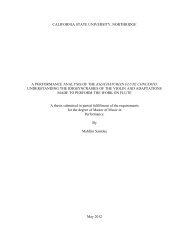Page 1 The California ""- Geographer Annual Publication of the ...
Page 1 The California ""- Geographer Annual Publication of the ...
Page 1 The California ""- Geographer Annual Publication of the ...
You also want an ePaper? Increase the reach of your titles
YUMPU automatically turns print PDFs into web optimized ePapers that Google loves.
TWO KEYS FOR THE HISTORICAL<br />
INTERPRETATION OF AERIAL PHOTOGRAPHS*<br />
RoBERT M. NEwcoMB<br />
Geographical Institute, University <strong>of</strong> Aarhus, Denmark<br />
<strong>The</strong> techniques and practices associated with <strong>the</strong> exploitation <strong>of</strong><br />
aerial photography in <strong>the</strong> study <strong>of</strong> air archaeology and historical geography<br />
were pioneered during ·world War I by German and British scholars. Mahy<br />
individuals contributed to <strong>the</strong> succeeding development and perfection <strong>of</strong><br />
methods, based upon experience in <strong>the</strong> field, during <strong>the</strong> next fifty years.<br />
0. G. S. Crawford, a leading British pioneer in this area, codified <strong>the</strong><br />
techniques <strong>of</strong> prehistorical interpretation when he devised a simple but<br />
most effective grouping <strong>of</strong> site attributes in two cornerstone publications.1<br />
<strong>The</strong> familiar categories <strong>of</strong> shadow-sites and shine marks, soil-sites, and<br />
crop-sites serve as foundational departure points for <strong>the</strong> archaeologist,<br />
anthropologist, and historical geographer working over ei<strong>the</strong>r vertical or<br />
oblique photographs. <strong>The</strong> full range <strong>of</strong> what can be achieved from photography<br />
in terms <strong>of</strong> ingenuous techniques working upon obscure data is<br />
splendidly illustrated by John Bradford in his Ancient Lanclscctpes.2 This<br />
much <strong>of</strong> technique and interpreted data is, <strong>the</strong>refore, secure, essential,<br />
and difficult to improve upon.<br />
<strong>The</strong> very rapid expansion <strong>of</strong> <strong>the</strong> usage <strong>of</strong> aerial photography in a<br />
wide number <strong>of</strong> fields and according to a bewildering variety <strong>of</strong> techniques<br />
is a development <strong>of</strong> <strong>the</strong> last 25 years. <strong>The</strong> photo interpretation key<br />
has been evolved to aid in <strong>the</strong> basic tasks <strong>of</strong> recognizing and identifying objects<br />
which appear on <strong>the</strong> photos, and two justifications for <strong>the</strong> development<br />
and use <strong>of</strong> keys have been agreed upon. 3 <strong>The</strong>y may serve as valuable short<br />
cuts in interpretation especially if highly trained personnel are not available,<br />
and <strong>the</strong>y assist greatly in <strong>the</strong> training <strong>of</strong> photo interpreters. It would seem<br />
that a third justification for <strong>the</strong> photo key might reside in <strong>the</strong> need to process<br />
<strong>the</strong> large volume <strong>of</strong> photography available today for <strong>the</strong> initial isolation<br />
<strong>of</strong> features which, by reason <strong>of</strong> <strong>the</strong>ir susceptibility to easy destruction, are<br />
rapidly passing from <strong>the</strong> visible scene. It is with this latter requirement foremost<br />
in mind that <strong>the</strong> following two photo interpretation keys are advanced<br />
as being suitable for usage by historical geographers.<br />
TYPES OF KEYS<br />
<strong>The</strong> photo interpreter endeavors to identify objects by employing<br />
processes <strong>of</strong> selection and <strong>of</strong> elimination. He can tell ei<strong>the</strong>r what something<br />
is, or he can identify and reject something which it is not. Both<br />
* This paper was originally delivered before Symposium S4a, "<strong>The</strong> Rural Landscape<br />
and its Evolution," <strong>of</strong> <strong>the</strong> 20th Congress, I.G.U., July 1964.<br />
1 0. G. S. Crawford, "Air-Survey and Archaeology," Ordnance Survey Pr<strong>of</strong>essional<br />
Paper, n.s. No. 7, (1924), 39 pp., and "Air-Photography for Archaeologists,"<br />
Ordnance Survey Pr<strong>of</strong>essional Paper, n.s. No. 12, (1929), 44 pp.<br />
2 John Bradford, Ancient Landscapes: Shtdies in Field Archaeology. London:<br />
George Bell, 1957, 297 pp.<br />
3 Interdepartmental Committee on Air Surveys, Department <strong>of</strong> Mines and<br />
Technical Surveys, Proceedings <strong>of</strong> a Seminar on Air Interpretation in <strong>the</strong> Development<br />
<strong>of</strong> Canada, (Ottawa), 1964, Pt. 4, pp. 38-40.<br />
37













